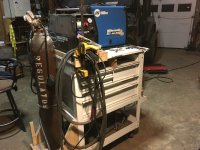MF RED in MT
Veteran Member
And the newer neighbor is getting tied of looking at it so he list on Free For The Taken........ My Miller211 is the same stile as your Miller140, just a hair more oomph and lot more $$, might be the next size up, they still make the 211 but different smaller version I assume it has the same out-put. Sounds like our duty cycle is about the same, comes with age....
Miller Millermatic 14 MIG Welder with Auto-Set for sale (97335) - Welding Supplies from IOC
Miller Millermatic 211 MIG Welder with Advanced Auto-Set for sale (97614) - Welding Supplies from IOC
I don't know if he'd give it away as he has plenty of room in his garage where mine is pretty full.
Yes that 140 AutoSet is exactly like mine, I purchased new in May 2010 for $649 and I think the Miller 180 AuotSet dual voltage was about $950 at that time.
My lifetime lease for a 80 cubic ft argon/co2 bottle was $200 full, and when I purchase another 80 cubic ft bottle of argon for tig welding it was $250 about 5 years ago,
Now I see your can purchase bottles empty from Amazon for about $160.
KC

